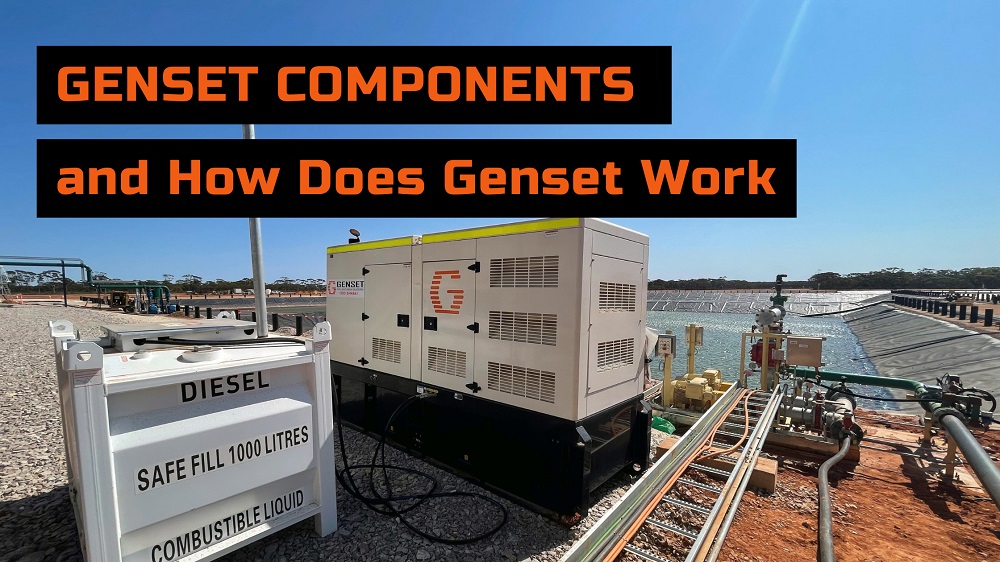In today’s fast-paced world, a reliable power source is essential to ensure smooth operations in various industries. Gensets, or generator sets, have become a crucial element in providing this much-needed power. This versatile power source is widely used in various applications, such as providing backup power during power outages, supporting construction projects, and ensuring uninterrupted power supply in remote locations.
As we delve into the world of gensets, we will explore their components and how they work and discuss their importance. So, whether you’re a seasoned professional in the industry or simply curious about how these powerful machines operate, we’ve got you covered.
Components of a Genset
To better understand how gensets work, it is important to familiarise ourselves with their key components. Each part plays a crucial role in the overall functioning and efficiency of the genset.
Engine
The engine is the primary source of mechanical energy in a genset. It is typically powered by diesel, natural gas, or propane, and its primary function is to drive the alternator. The engine’s size and power output determine the overall capacity of the genset.
Alternator
The alternator, also known as the generator, is responsible for converting the mechanical energy generated by the engine into electrical energy. It compromises a stator (stationary part) and a rotor (rotating part), which work together to produce electromagnetic field that generates electricity.
Controller/Control Panel
The controller, or control panel, is the brain of the genset. It monitors and manages the genset’s performance, including starting and stopping the engine, regulating voltage, and protecting the genset from potential damage due to overloads or other issues. It may also provide remote monitoring and control capabilities.
Chassis
The chassis is the structural framework that supports and houses all the genset components. It is typically made of steel or other sturdy materials to ensure stability and durability. The chassis also includes vibration isolators to minimise noise and vibrations during operation.
Battery
The battery provides the initial power required to start the engine. It is essential to maintain the battery in good condition to ensure reliable and efficient genset operation.
Container
The container encloses the genset, providing protection from environmental factors such dust, moisture, and extreme temperatures. It also helps reduce noise levels during operation. Containers are often designed for easy transportation and installation, making them suitable for various applications.
Reefer
A reefer, or refrigeration unit, is an optional component used in gensets designed for temperature-sensitive applications, such as cold storage or transportation of perishable goods. The reefer helps maintain the desired temperature inside the container, ensuring optimal performance and protecting the genset from potential damage due to extreme temperature fluctuations.
Working Principle of a Genset
Now that we have a clear understanding of the various components of a genset, let’s dive into the working principle that governs its operation.
1. Startup Procedure
The startup procedure begins with the control panel sending a signal to the battery to initiate the engine’s ignition. Once the engine starts, it begins to generate mechanical energy, which is then transferred to the alternator. The genset’s controller monitors the engine’s performance and ensures that it reaches the required speed and output before supplying power to the connected load.
2. Power Generation
As the engine generates mechanical energy, the alternator converts it into electrical energy. This is achieved through the interaction of the stator and rotor within the alternator, creating an electromagnetic field that generates electricity. The voltage and frequency of the generated power are regulated by the controller to ensure a stable and consistent output.
3. Load Response
The genset’s ability to respond to changes in load is crucial for maintaining stable power output. As the load on the genset increases or decreases, the controller adjusts the engine’s speed and fuel supply accordingly to maintain the desired output voltage and frequency. This ensures that the genset can effectively handle varying power demands while maintaining optimal performance and efficiency.
4. Shutdown Process
When the genset is no longer needed, the shutdown process begins. The controller sends a signal to stop the engine, cutting off the fuel supply and allowing the engine to gradually come to a stop. Once the engine has stopped, the controller ensures that all safety features are engaged and the genset is ready for its next startup. Proper shutdown procedures are essential for prolonging the life of the genset and ensuring its reliable operation.
Choose Genset Hire and Sales Australia for Your Power Needs
When it comes to reliable, efficient, and high-quality genset solutions, look no further than Genset Hire and Sales Australia (GHASA). With our extensive range of products and services, we are committed to meeting your specific power requirements and ensuring the smooth operation of your business or project.
Our team of experienced professionals is dedicated to providing exceptional customer service and expert advice, guiding you through the selection process to find the perfect genset for your needs. Whether you require a backup power solution, support for a construction project, or a dependable power source for a remote location, GHASA has you covered.
Don’t compromise on your power needs. Trust the experts at Genset Hire and Sales Australia to provide the best genset solutions tailored to your requirements. Contact us today and let us be your partner in powering your success.


